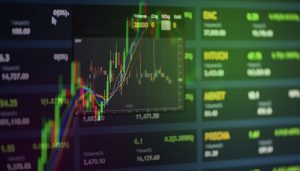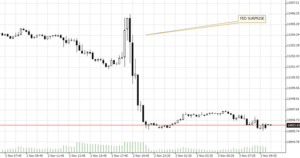

03.11.2022 – In, up, down, out: As expected, the Federal Reserve has shaken the markets vigorously. The reason for the great devouring of the stop-loss marks: A violent turnaround in the tonality of the Fed between press release and press conference. One could almost suspect a deliberate slaughter of the bulls behind yesterday. Or we are dealing with a horrendous case of split personality.
First the euphoria, then the cold shower. After the press release on the interest rate move, things initially went up. During Jerome Powell’s press conference, nervousness increased. And ultimately it went south. You can see the Fed surprise very nicely in the 15-minute chart of the Nasdaq 100.

Source: Bernstein Bank GmbH
First the facts: The central bank again raised the key interest rate significantly. The key rate rose by 0.75 percent to a range of 3.75 to 4 percent. This is the Fed’s fourth major rate hike since March. Powell admitted admitted that the central bank was considering a smaller interest rate step in December. Thus, that could have been the last jumbo rate move this year. However, this does not mean a pause in the rate hike. So the interest rate will rise, come what may.
The horror of Mr. Hyde
Now for the background: The most interesting explanation for the drama yesterday we found at the brilliant financial blog “ZeroHedge”, which referred to trader John Flood of Goldman Sachs. According to this, the affair played out yesterday like the horror classic Dr. Jekyll and Mr. Hyde. Apparently, the Fed press release had been written by Fed Vice Chair Lael Brainard, known as a dove, this had triggered a small buying frenzy. And then the evil Mr. Powell stepped to the microphone: “incoming data since our last meeting suggests that the ultimate level of interest rates will be higher than previously expected.”
Higher for longer
Powell actually spoke unusually plainly: “the labor market continues to be out of balance, with demand substantially exceeding the supply of available workers.” Looking at inflation plus the labor market, the Fed has two reasons at once to continue tightening. And further, “We have some ways to go. (…) “The question of when to moderate the pace of increases is now much less important than the question of how high to raise rates and how long to keep monetary policy restrictive.” The bottom line for the market: higher for longer. Not good for stocks, especially growth stocks.
No reliance
And another take-home message: not only is the Fed as a body no longer reliable because it disagrees. But the Fed chief also has a deficit. Powell has basically done an about-face, as commentator Ye Xie of Bloomberg put it: “Prior to the pandemic, the Fed’s story line has been that they’d rather let inflation run hot, than allowing inflation to stay too low for too long. It’s easier to deal with inflation than deflation, so goes the argument. Today, Powell says it’s the other way around.” He said the Fed has the tools necessary to clean up over-tightening rather than those to allow inflation to run for too long.
Our Bottom Line: Times have changed. Inflation appears more dangerous to the Fed than deflation, read: recession. Moreover, a power struggle between doves and hawks is apparently raging within the Fed. The trouble is that there is no unified line of communication. But how should traders and investors position themselves when even the Fed is constantly pivoting? We keep the matter on our radar for you and wish good luck despite everything!
____________________________________________________________________________________________________________________________________________________________________
The content of this publication is for general information purposes only. In this context, it is neither an individual investment recommendation or advice nor an offer to purchase or sell securities or other financial products. The content in question and all the information contained therein do not in any way replace individual investor- or investment-oriented advice. No reliable forecast or indication for the future is possible with respect to any presentation or information on the present or past performance of the relevant underlying assets. All information and data presented in this publication are based on reliable sources. However, Bernstein Bank does not guarantee that the information and data contained in this publication is up-to-date, correct and complete. Securities traded on the financial markets are subject to price fluctuations. A contract for difference (CFD) is also a financial instrument with leverage effect. Against this backdrop, CFD trading involves a high risk up to the point of total loss and may not be suitable for all investors. Therefore, make sure that you have fully understood all the correlating risks. If necessary, ask for independent advice. CFDs are complex instruments and are associated with the high risk of losing money quickly because of the leverage effect. 68% of retail investor accounts lose money trading CFD with this provider. You should consider whether you understand how CFD work and whether you can afford to take the high risk of losing your money.7
